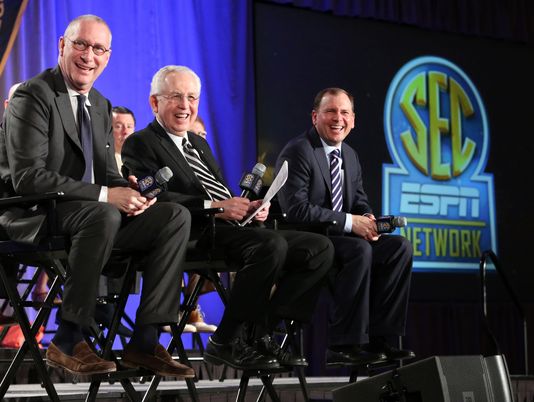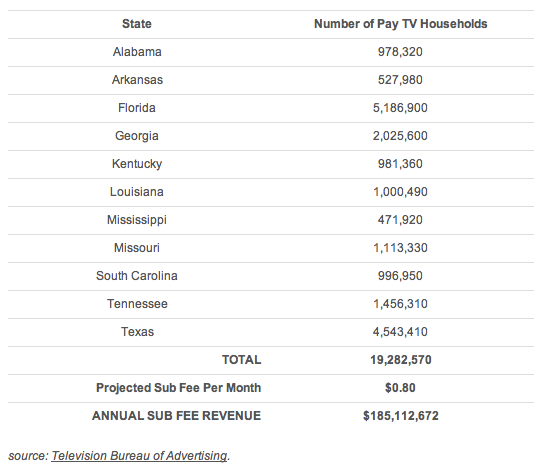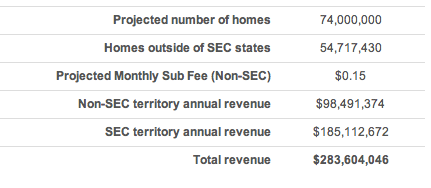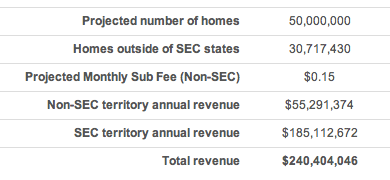
Editorial Note: We're proud to announce Dave Warner as an addition to Awful Announcing. This article appears courtesy Dave's site, What You Pay For Sports. We'll be syndicating some of Dave's work at AA and feature original pieces in the weeks to come.
Do you live in SEC Country? Do you pay for cable or satellite TV? Congratulations! Your cable bill is going up yet another 80 cents per month next year!
Of course, if you’re an alumnus or fan of an Southeastern Conference school, you probably won’t mind, as that 80 cents will pay for the new SEC Network, which was formally announced today in conjunction with ESPN. The new network will launch in August of 2014, and ESPN president John Skipper insisted that it would be a “national network” on par with ESPNU, which is currently in 74 million homes.
Getting the SEC Network into that many homes, of course, will require a bit of massaging. After all, this channel won’t be able to fetch nearly as much money in Michigan or California as it will in Alabama and Mississippi. The bulk of the SEC Network’s viewership will be in the 11 states where SEC schools are located. That’s where the subscriber fees will be the highest.
How high? Currently, the Big Ten Network and Pac-12 Network both collect upwards of $0.80/month per subscriber within their regions. (This explains why the Big Ten desperately wants New Yorkers to care about Rutgers.) The subscriber fee for the SEC Network should be roughly the same in SEC states. Let’s take a look at how many households in those 11 states get pay TV, and what they’ll be adding to the SEC Network coffers:

Remember, that's $0.80 x 12 x 19,282,570. That’s how much the SEC Network stands to make per year from just those 11 states. As a “national network”, however, it won’t be able to charge nearly as much outside of SEC territory; the average subscriber fee in non-SEC territories will be closer to what ESPNU makes. It might even be a few cents lower.
Let’s project, then, that the SEC Network’s sub fee in non-SEC states averages out to roughly $0.15/month. If ESPN is successful in getting this channel into all the same 74 million homes as ESPNU, here’s what it stands to make:

By these numbers, the SEC Network’s average subscriber fee for the entire nation would be $0.32/month. The Big Ten Network’s national average is $0.36/month, but it only reaches 50 million homes. How would the SEC Network do if it only got into 50 million homes?
Yeah, I think they’ll do okay.
As for the 14 SEC schools themselves, they can expect to get at least $10 million each from this network. Combine that with the $205 million annually that the conference already gets from ESPN and CBS, and those schools will receive nearly $25 million each in TV money alone. Only the Pac-12, at a projected $30 million per school annually, would make more from its TV deals than the SEC.
Little wonder, then, that South Carolina head football coach Steve Spurrier questioned when the players themselves might see some of this money. It’s a fair question, and one which all pay TV subscribers should be asking. After all, cable TV money foots the bill for college sports. We pay for ESPN and Fox, ESPN and Fox give the Big 12 $200 million per year, the Big 12 gives Oklahoma University $20 million per year, OU gives head football coach Bob Stoops $4 million per year, and Bob Stoops gives OU’s football players… lectures about how they’re not the only college kids going hungry on Sunday nights.
Clearly, the college sports system could use an overhaul. This might be one reason why big conferences are so eager to launch their own cable networks. When schools are collecting $25-30 million each in TV money, why exactly do they need the NCAA to tell them how to run their operations? Why do bowl games need the NCAA if the money is coming from ESPN? Is the NCAA Basketball Tournament still worth it if schools get only $1-2 million each from it? Every dollar of TV money will make these questions a little bit louder. At some point soon, they’re bound to dominate the conversation entirely.
Courtesy What You Pay For Sports.







